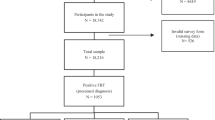Abstract
The Netherlands has wellorganized school health services, and children are assessed on a regular basis for scoliosis among other disturbances and pathologies. The purpose of this study was to assess the benefits of an annual screening programme for scoliosis in the Netherlands. Three cohorts of 10 000 children sampled at 10, 12 and 14 years of age, respectively, were followed for 3 years. Children with a positive bending sign were referred to a second screening stage, in which external asymmetry was quantified. Children diagnosed via the programme (group 1) were compared with those children who had been referred for treatment independently of the screening (group 2). The total number of children in these groups combined was then compared with the number that would have been expected on the basis of accepted prevalence figures for idiopathic scoliosis given in current literature. Over 30 000 children were screened. Although the programme established a total of 57 cases of definite scoliosis (0.18%), the 34 cases (0.11%) already known, mainly detected by previous school health checks, were more severe regarding the risk of progression and treatment. The annual screening programme did not detect a single case that needed surgery. These figures provide the basis on which to decide for or against adopting an annual screening programme for scoliosis; the discision is a socio-political one. Based on this study, we expect all scoliotic patients needing treatment should be detected in time if periodic health checks will be maintained biennially. On medical grounds, it is our view, that screening for scoliosis should not be performed in the Netherlands annually.
Similar content being viewed by others

References
Asher M, Beringer GB, Orrick J, Halverhout N (1989) The current status of scoliosis screening in North America, 1986. Results of a survey by mailed questionnaire. Spine 14: 652–662
Ashworth MA, Ersil AK (1981) The measurement of rib hump inclination —a potential aid in scoliosis screening. Orthop Trans 5: 33–34
Bleck EE (1989) School screening for scoliosis (correspondence). Acta Orthop Scand 60: 123
Brooks HL, Azen SP, Gerberg E, Brooks R, Chan L (1975) Scoliosis: a prospective epidemiological study. J Bone Joint Surg [Am] 57: 968–972
Bunnell WP (1984) An objective criterion for scoliosis screening. J Bone Joint Surg [Am] 66: 1381–1387
Bunnell WP (1989) Treating scoliosis. West J Med 150: 6:683
Burwell G (1988) The British decision and subsequent events. Spine 13: 1192–1194
Burwell RG, Webb JK, More EJ (1981) School screening for scoliosis. Lancet (letter) II: 863
Kane WJ (1977) Scoliosis prevalence: a call for a statement of terms. Clin Orthop 126: 43–46
Lonstein JE (1988) Why school screening for scoliosis should be continued. Spine 13: 1198–1199
Lonstein JE, Carlson JM (1984) The prediction of curve progression in untreated idiopathic scoliosis during growth. J Bone Joint Surg [Am] 66: 1061–1071
Lonstein JE, Bjorklund S, Wanninger MH, Nelson RP (1982) Voluntary school screening for scoliosis in Minesota. J Bone Joint Surg [Am] 64: 481–488
Montgomery F, Willner S (1993) Screening for idiopathic scoliosis, comparison of 90 cases shows less surgery by early diagnosis. Acta Orthop Scand 64: 456–458
Nachemson A (1989) School screening for scoliosis (correspondence). Acta Orthop Scand 60: 124
Nissinen M, Heliovaara M, Ylikoski M, Poussa M (1993) Trunk asymmetry and screening for scoliosis: a longitudinal cohort study of pubertal children. Acta Paediatr 82: 77–82
Ohtsuka Y, Yamagata M, Arai S, Kitahara H, Minami S (1988) School screening for scoliosis by the Chiba University Medical School screening program. Results of 1.24 million students. Spine 13: 1251–1257
Ponte A (1982) Prognostic evaluation of vertebral rotation in small idiopathic curves. Proc Scoliosis Res Soc 6: 6
Pruijs JEH, Keessen W, Meer R van der, Wieringen JC van, Hageman MAPE (1992) School screening for scoliosis: methodological considerations. 1. External measurements. Spine 17: 431–436
Renshaw TS (1988) Screening school children for scoliosis. Clin Orthop 229: 26–33
Vercauteren M, Beneden M van, Verplaetse R, Croene Ph, Uyttendaele D, Verdonk R (1982) Trunk asymmetries in a Belgian school population. Spine 7: 555–562
Willner S (1979) Moiré topography for the diagnosis and documentation of scoliosis. Acta Orthop Scand 50: 295–302
Willner S (1989) School screening for scoliosis. Acta Orthop Scand 60: 124
Winter RB (1994) The pendulum has swung too far: bracing for adolescent idiopathic scoliosis in the 1990s. Orthop Clin North Am 25: 195–204
Author information
Authors and Affiliations
Additional information
Dr. W. Keessen, initator of this study, died in December 1993
Rights and permissions
About this article
Cite this article
Pruijs, J.E.H., van der Meer, R., Hageman, M.A.P.E. et al. The benefits of school screening for scoliosis in the central part of the Netherlands. Eur Spine J 5, 374–379 (1996). https://doi.org/10.1007/BF00301964
Received:
Revised:
Accepted:
Issue Date:
DOI: https://doi.org/10.1007/BF00301964



